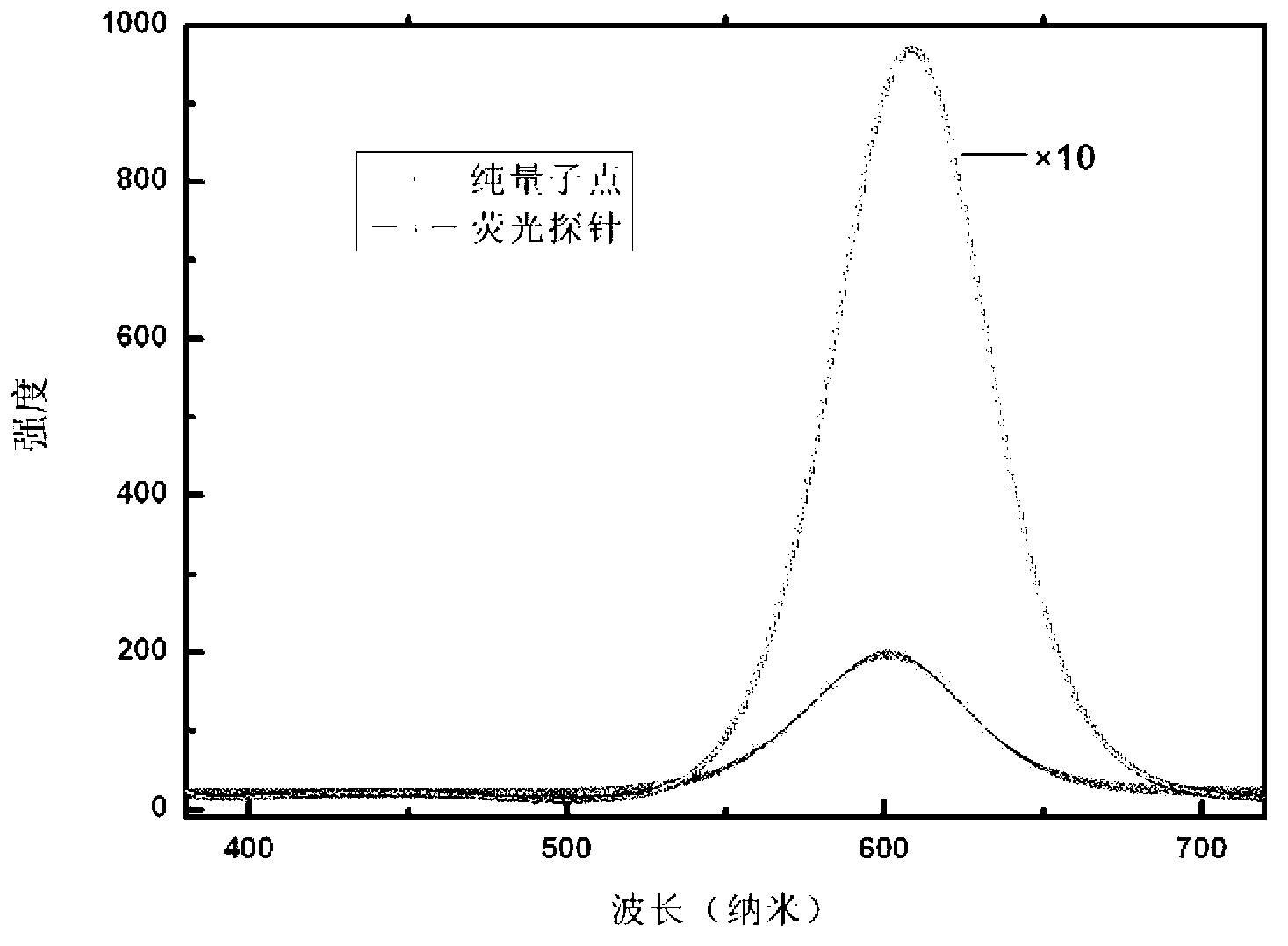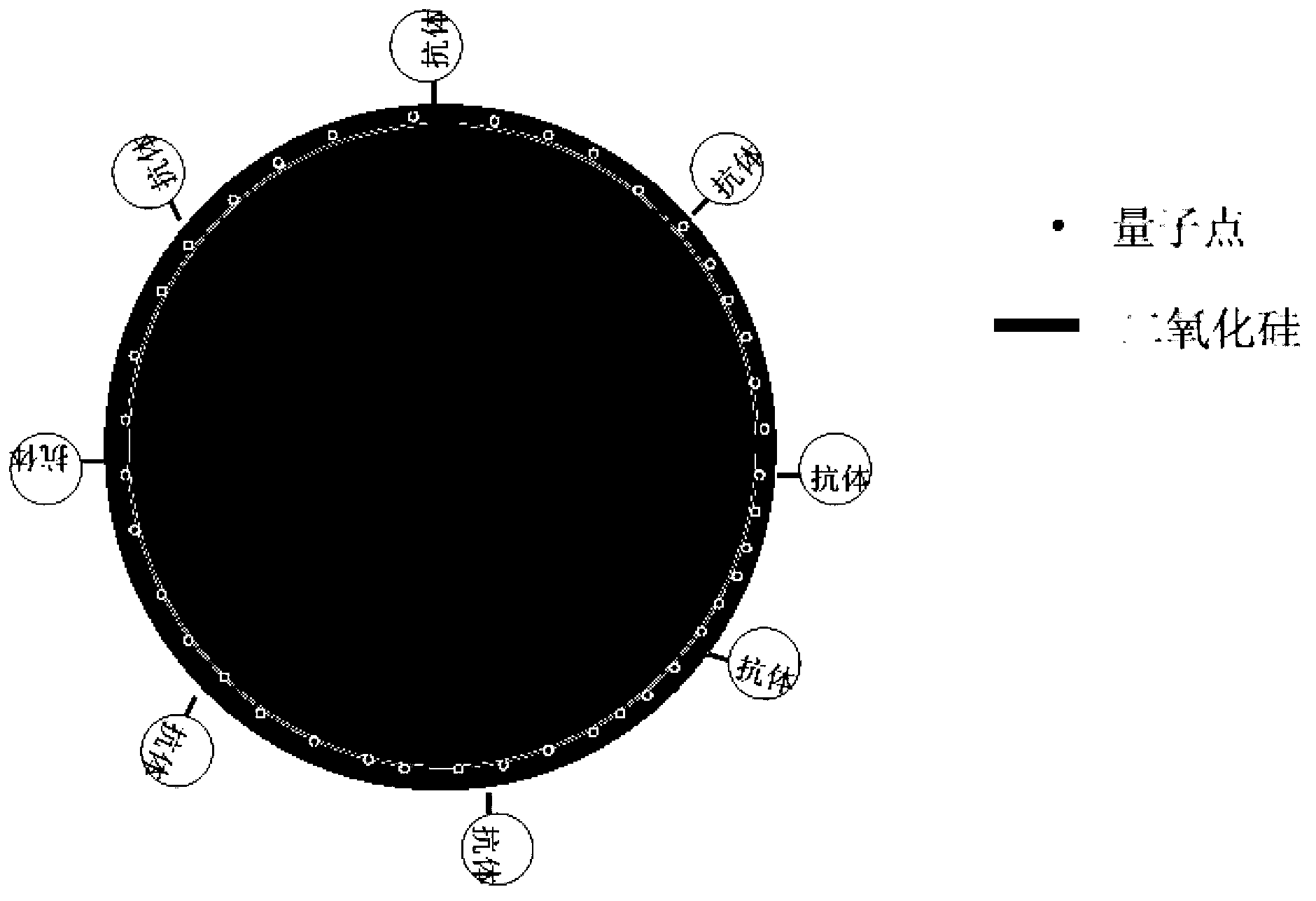High-brightness non-toxic fluorescent quantum dot nanometer composite probe and preparation method thereof
A fluorescent quantum dot and nanocomposite technology, which is applied in the field of fluorescent quantum dot nanocomposite probes and their preparation, can solve problems such as poor biocompatibility and biotoxicity, and achieve good biocompatibility, good biocompatibility, The effect of preventing the fluorescence quenching effect
- Summary
- Abstract
- Description
- Claims
- Application Information
AI Technical Summary
Problems solved by technology
Method used
Image
Examples
Embodiment 1
[0035] (1) Hydrolyze 2ml of tetraethyl orthosilicate (TEOS) under the catalysis of 4ml of ammonia water, and react at 40°C for 4 hours to prepare a silica sol with a diameter of 80nm.
[0036] (2) The prepared silica sol was modified with 200 microliters of 3-aminopropyltrimethoxysiloxane (APTMS) to bring amino groups on its surface, and then centrifuged to remove excess APTMS, Then 5ml concentration is that the MPA stabilized water-soluble fluorescent CdTeS quantum dot of 2M is added in the silica sol that has been modified, reacts 24 hours and makes it react fully, centrifuges then, and centrifugal product is dispersed in ethanol (the ethanol consumption is able to Just disperse the centrifuged product).
[0037] (3) Add 2ml of ammonia water and 1000 microliters of TEOS to the composite material prepared in (2). TEOS is hydrolyzed under the catalysis of ammonia water. The reaction condition is to react at room temperature for 24 hours. After the reaction, use γ-mercaptopropy...
Embodiment 2
[0040] (1) Hydrolyze 4.4ml of tetraethyl orthosilicate (TEOS) under the catalytic action of 8ml of ammonia water, and react at 80°C for 2 hours to prepare a silica sol with a diameter of 150nm.
[0041] (2) The prepared silica sol was modified with 500 microliters of aminopropyltriethoxysilane to bring amino groups on its surface, followed by centrifugation to remove excess APTMS, and then 10ml of 2M The MPA stabilized water-soluble fluorescent CdTe quantum dots were added to the modified silica sol, reacted for 24 hours to fully react, and then centrifuged and dispersed in isopropanol.
[0042] (3) Add 4ml of ammonia water and 5000 microliters of TEOS to the composite material prepared in (2). TEOS is hydrolyzed under the catalysis of ammonia water. The reaction condition is to react at room temperature for 24 hours. After the reaction, use 3-aminopropyl Trimethoxysiloxane (APTMS)) modified with amino groups on the surface. (4) Add antibodies to the quantum dot fluorescent c...
Embodiment 3
[0044](1) Hydrolyze 0.55ml of tetraethyl orthosilicate (TEOS) under the catalytic action of 2ml of ammonia water, and react at 25°C for 12 hours to prepare a silica sol with a diameter of 110nm.
[0045] (2) The prepared silica sol was modified with 100 microliters of 3-aminopropyltrimethoxysiloxane (APTMS) to bring amino groups on its surface, and then centrifuged to remove excess APTMS, Then 3ml of MPA-stabilized water-soluble fluorescent Mn-doped ZnS quantum dots with a concentration of 2M was added to the modified silica sol, reacted for 24 hours to fully react, and then centrifuged and dispersed in ethanol.
[0046] (3) Add 1ml of ammonia water and 500 microliters of TEOS to the composite material prepared in (2). TEOS is hydrolyzed under the catalysis of ammonia water. The reaction condition is to react at room temperature for 24 hours. After the reaction, use Modified silane coupling agents (such as 3-aminopropyltrimethoxysiloxane (APTMS)) make the surface with amino gr...
PUM
| Property | Measurement | Unit |
|---|---|---|
| size | aaaaa | aaaaa |
Abstract
Description
Claims
Application Information
 Login to View More
Login to View More - R&D
- Intellectual Property
- Life Sciences
- Materials
- Tech Scout
- Unparalleled Data Quality
- Higher Quality Content
- 60% Fewer Hallucinations
Browse by: Latest US Patents, China's latest patents, Technical Efficacy Thesaurus, Application Domain, Technology Topic, Popular Technical Reports.
© 2025 PatSnap. All rights reserved.Legal|Privacy policy|Modern Slavery Act Transparency Statement|Sitemap|About US| Contact US: help@patsnap.com



